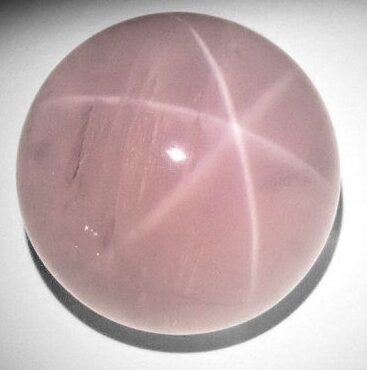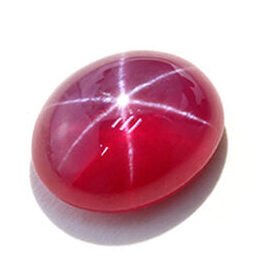The Twinkle of Star Gems
Stars, the twinkly dots above our night sky, create amazing sceneries on what seemed to be a black blank space. Before the times of electricity and technology, the stars above helped humans in many ways, from guiding sailors to becoming an entertainment. It even inspired the creations of the horoscopes. So just when we thought of holding the star with our fingers, Mother Earth presents us stars in the form of gemstones, star gems.

The star in the gem is actually a special optical effect, known as asterism in gemmology, produced by phenomenal gemstones. Under the right circumstances, the gemstone will illuminate a star-like pattern just under the stone’s surface when interacted with light. Asterism usually displays a 6-ray star, but also can be found in 4-ray and rarely 12-ray stars in specific gemstones. We know a single band of light is referred to as chatoyancy or cat’s eye, whereas when few bands are visible and intersect each other for which it becomes a star.
This phenomenon can be found in a variety of gemstones, such as quartz, moonstone, garnet, diopside, etc. Rose quartz often produces prominent star, as for phenomenal garnets and dipoles exhibit 4-ray star. Perhaps asterism is more famously known for in corundums, ruby and sapphire. Sapphire in particular, consisted of many largest and well-known star gemstones that existed. Sapphires like the “Black Star of Queensland”, “Star of Asia”, “Star of India”, and the largest of them all “Star of Adam” which weighs over 1400ct.

The science behind the asterism is pretty straight forward, caused by inclusions present in the gemstone. Those inclusions commonly consist of rutile needles, or sometimes known as “silk”, in most star gems. Although other inclusions like hematite and magnetite needles also cause star effect in specific gemstones. These inclusions are parallel oriented in an angle where they catch and reflect light from a certain light position. Due to the fact that the mentioned inclusions are metallic, thus they have fairly good reflective surfaces to create a distinct star.

These inclusions are one of the most common inclusions present in corundum due to closely related chemical composition. Typically it would be oriented at a 60 degree angle that formed a 6-ray star during the growth of the crystal. Other gems may have different orientations. Of all the stars, the 12-ray star perhaps is the rarest. In this rare star, additionally to the set of rutile needles it has another set of ilmenite-hematite needles that formed in another direction. Hence, both combined to create the 12-ray star.
Why is asterism often found in corundum? That should point to its crystal structure. Not typical that a gem often shows its growth structure more than corundum. Growth zonings can be seen and those are where the inclusions form along, parallel to the growth planes and perpendicular to the c-axis of the crystal. C-axis refers to the length of the crystal, from the base to the tip. Cutters will also cut perpendicular to the c-axis to showcase the phenomenon of the gem.
For a star gem, the star the gem possesses matters the most. It will determine the overall quality and value; of course it would be an added bonus should there be vivid colouration. To judge the star, one has to look at a few factors: sharpness, position, and uniformity. Top quality stars should be distinct and fine, well-centered on the stone, and the bands should run from center to the base, easier said than done.

Another two aspects are the cut and colour of the gem. The cut of a star gem is always the cabochon, either a round or oval dome shape. Basically the symmetry of the shape beautifies the overall appearance. Good craftsmanship will always add value. Final aspect will be the colour. The quality of colour does not always apply to all star gemstones. Gemstones like star quartz, which usually have a consistent pink colour, and star diopside, which emphasised on the quality of the star, are able to disregard this aspect of colour. Ruby and sapphire’s colour though, will be judged to its overall gem quality.

Apart from the usual 6-ray star, there are many other varieties of star available. For instance, the 4-ray star only is shown by a handful of gemstones as mentioned above. Star diopside considered to be the more peculiar one as its star is not formed at a 90 degree angle like other 4-ray star gems. Its outlook also appeared to be wavier and less distinct. Next, the rare and highly prized 12-ray is only known to be found in sapphires. On top of the obvious set of rutile star, the second set however is usually faint.
Coming up is the multiple-star gems. Multi-star refers to more than one star shown on the gem with one light source. Mostly seen in spherical quartz, it involves the reflection of light that passes through the stone, thus creating another star that appears to be on the opposite side of the original star. Although sapphires can also have multiple stars, their mechanics are totally different from quartz. Unlike quartz, star sapphires are often opaque. It is likely that both sets of stars are caused by the same inclusions with the same orientation but in different locations on the stone.
No matter what kind of star or gem, all of these prove the wonder of nature. To create a magical star, it requires elements like the right chemical, the presence of inclusions and the orientation of it, and most important of all, sunlight / light. To have such wonder on one’s finger is truly a blessing by nature.



Hi ! My name is Marco, I am from Hong Kong and frequently travel to China for business, recently I am working on a procurement project of Salt and Pepper diamonds, Gem stones and customise engagement rings for China Market. Wonder if you interested to work together with me for such huge market opportunity. Please see my email five_elements@hotmail.com or WhatsApp 852-91753432 for further. Thanks!
Hi, Thank you for your message. Unfortunately, we are not in the midst of purchasing products for the museum. We hope for the best for you!